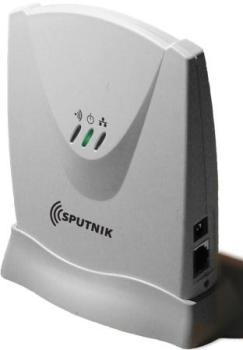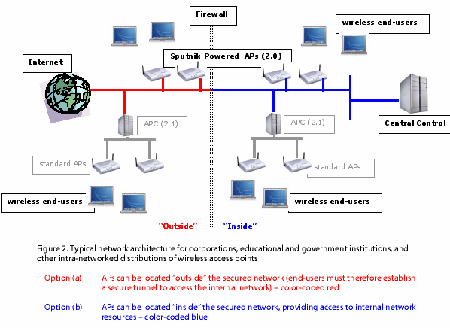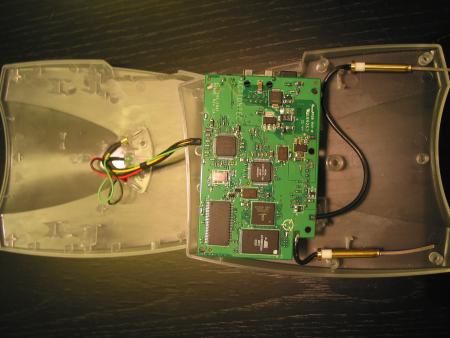Device Profile: Sputnik wireless network management platform
Oct 14, 2003 — by LinuxDevices Staff — from the LinuxDevices Archive — 9 viewsSputnik is a wireless network management system based on Linux and embedded Linux software combined with commodity PC and wireless access point (AP) hardware. It targets wireless Internet service providers (WISPS), community wireless service providers, educational campuses, and system integrators who want to centrally manage their customers' networks.
This article takes a look at the whole system, which comprises two Linux applications, and, almost incidentally (and optionally, as far as the system goes), one device running embedded Linux.

Figure 1: Basic Sputnik network architecture
At its most basic, the Sputnik system comprises Sputnik Central Control (SCC), server software that installs as RPMs on Red Hat 9 (and soon to be packaged for Debian as well), and the Sputnik Agent (SA), software compiled for commodity access points or PCs, comprising about 100KB of code, and presently available pre-installed on Sputnik's $185 802.11b AP 120.
Sputnik Central Control (SCC)
SCC provides a secure Web-based interface to wireless networks, enabling the administrator to track who is on the network, see how much bandwidth they consume, manage end-users, define policies, create captive portal pages, view a number of pre-defined reports, and create custom reports, according to Sputnik. Built around a set of open interfaces and languages, SCC enables customers to use different billing, settlement, authentication, and network management systems, the company says. An open SQL schema supports direct SQL queries through a form on the Web interface for advanced users.
SCC is sold under a commercial license for $895, or for free to participants in Sputnik's limited availability release program, which will end very soon, according to Sputnik CEO David LaDuke, with the “2.1” releases of SCC and SA. The basic license includes 20 APs, but a single SCC can manage “hundreds” of APs, with volume licensing discounts available.
Sputnik lists the following features for SCC 2.0:
- Easy Web-based administration
- Built-in Authentication, Authorization, and Accounting (AAA) of end-users
- Centralized status and configuration of Sputnik-powered APs
- Real-time telemetry and historical reporting of end-user and AP bandwidth usage in hourly, daily, weekly, and monthly durations
- RPM-based installation that installs on Red Hat 9 (Debian coming soon)
Sputnik Agent
The Sputnik Agent (SA) is about 100KB of portable code designed to be incorporated into the firmware of commodity wireless access points. The Sputnik Agent provides all of the manageability hooks that enable automatic configuration, dynamic firewalling, multiple captive portal redirects, policy routing, centralized management, and end-user tracking. OEMs can license the Sputnik Agent on a royalty-free, worldwide basis, including source code access.
Currently, the only Sputnik-enabled AP is Sputnik's own AP 120, which runs SA on an embedded uClinux OS. The AP 120 is built around the “Rockhopper” platform for 802.11b from Intersil, which has recently reorganized as Globalspan.
Sputnik is working on a device using the WISOC platform, also known as “Duette,” which is Intersil/Globalspan's combined 802.11-b and -g platform. And, “We would love to work with Broadcom, Atheros, and Intel as well — and we've contacted all of these folks. It's a matter of time,” says LaDuke.
LaDuke notes, “We look forward to the day when we can announce the availability of the Sputnik Agent as a free firmware upgrade to a mainstream AP. While we will probably always offer some form of Sputnik AP hardware, our focus is on being a software provider. We'd rather see third party AP manufacturers embrace the Sputnik Agent.”
Sputnik lists the following features for Sputnik Agent 2.0 when combined with commodity AP functionality:
- Captive portal redirect (customer-branded experience to ssl-authenticate and allow self-registration of end-users when they first open a browser)
- “Guest” policy to deny self-registered end-users from access to any internal/company networks
- DHCP server
- NAT (network address translation)
- Web server (for individual unit maintenance and new firmware uploads)
- Dynamic Firewall
- DNS and VPN pass through
- SNMP server
- Support for up to 250 concurrent users
- Set WEP keys (if desired)
- And other typical AP functionality

Sputnik's $185 AP 120 comes with Sputnik Agent preinstalled
Embedded programmers can “sputnify” an AP themselves, according to Sputnik's Director of Product Management Kathy Giori. “You'd either need a complete flash image from us or the OEM that already includes the Agent — in other words, supported hardware — or you could take our Agent source code and compile it for the Linux OS that runs on your device.”
AP Concentrator
Sputnik will soon offer an AP Concentrator, software that boots from a CD on an inexpensive PC with two network interfaces to enable one or more unmodified third-party APs to be managed by Sputnik Central Control. The AP Concentrator includes Sputnik Agent, minus the wireless parts — it has no radio. Sputnik claims that the administrative and end-user experiences are the same, whether the end-users access the wireless network via a Sputnik-powered AP, or a standard AP networked through an AP Concentrator, except that in the case of the concentrator, only aggregate bandwidth usage is available, verses the AP-by-AP information available when using Sputnik AP 120s or other Sputnik-enabled APs.
Giori notes that programmers can create AP Concentrators by adding the Sputnik Agent to the compact flash of a single board computer (SBC) such as a Soekris box that supports two NICs.

Figure 2: More complex Sputnik network architecture
(Click image to enlarge)
“Using a combination of free, embedded firmware (the Sputnik Agent) and server software (SCC), we are committed to bringing Cisco-class network management and security features to commodity access points,” says Sputnik CEO David LaDuke.
The hardware side
Sputnik lists the following minimum requirements for the system on which SCC will be installed and run:
- Pentium II-class processor
- 64 MB RAM
- bootable CD-ROM drive
- 2GB hard drive
- Ethernet network interface card
- keyboard, monitor, and mouse.
Requirements for Sputnik's AP Concentrator are:
- Pentium II or faster Intel-based processor
- 64MB RAM
- CD-ROM drive (bootable)
- 2 NICs (standard Ethernet interface cards)
- keyboard, monitor, mouse
The Sputnik AP 120 is based on an ARM9 processor running at 180MHz. It has 8MB of RAM, and boots from 2MB of Flash memory. It includes a wired 10/100Base-T Ethernet port (RJ-45) and a wireless interface based on IEEE802.11b.

Inside the Sputnik AP 120
(Click image for an enlarged view of the SBC)
The software side
As mentioned earlier, the Sputnik AP 120 runs uCLinux as its embedded OS. Sputnik says it developed its Sputnik Agent software solution in-house, on top of an existing firmware reference design produced by Intersil/Globalspan.
SCC was also developed in-house, although it depends on many open source components developed and maintained by the Linux community at large. “We have also received excellent support from the Progeny Group on Debian-related matters,” notes Giori. Progeny is a Linux “Platform Services Provider” co-founded by Debian Project originator Ian Murdock, who serves as CTO.
Both the AP and the SCC are configured through their respective web-based interfaces. AP configuration can be as simple as entering the URL of the SCC server, Sputnik claims, enabling APs to be self-installed at hot spot locations. “As long as the AP has an Internet connection, it will find the designated SCC server and auto-provision itself with the appropriate configurations,” notes Giori.
Secure communication between the SCC and the APs is done via Jabber, an open XML protocol for the real-time exchange of messages and presence between any two points on the Internet. The SCC server must have a domain name that is resolvable over the Internet, since Jabber communications rely on name resolution.
Imagine that: Jabber instant messaging used as an autonomous embedded software component!
Why Linux?
Sputnik says it chose embedded Linux for its AP 120 access point because it's free, it's becoming a standard on wireless access points, and it's open and extensible.
Additionally, the company chose Linux for the SCC because it had all needed features and added no costs to the software distribution. “Using Linux allows us to package and provide managed WiFi server software as a complete solution, yet at an affordable price,” says LaDuke.
Giori notes that the biggest challenge with regard to using embedded Linux for the project was the need to constrain software to fit within the resource boundaries of the embedded Linux access point. “The biggest trick was wanting to take advantage of existing open source software libraries, but finding that they didn't fit. Because of that limitation, we often had to write code from scratch.”
LaDuke predicts that the use of embedded Linux for wireless access points will continue to proliferate. “Linux running on APs makes great sense and is bound to have a very bright future!” says LaDuke.
This article was originally published on LinuxDevices.com and has been donated to the open source community by QuinStreet Inc. Please visit LinuxToday.com for up-to-date news and articles about Linux and open source.